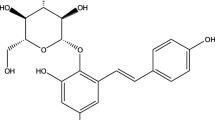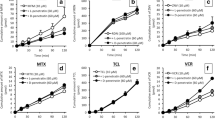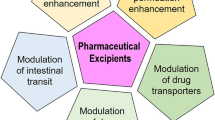Abstract
Purpose. Different lipophilic derivatives of a potent αΙΙbβ3- antagonist with benzamidino-oxazolidinone structure were investigated with respect to transport and metabolism properties to evaluate their potential as prodrugs with improved absorption behavior.
Methods. Intestinal transport and metabolism of the compounds were studied in Caco-2 monolayers under in vitro conditions and quantitated by a reversed-phase HPLC- method. Peroral bioavailability in cynomolgus monkeys and inhibition of platelet aggregation (guinea pig) were compared to in vitro permeability coefficients.
Results. N-alkoxycarbonyl- and N-benzoyl- derivatization of the benzamidine-parent drug increased the apparent permeabilities across Caco-2 monolayers by a factor of 25-100 fold. Most prodrugs were transported mainly by passive diffusion, whereas the methoxycarbonyl-derivative EMD 122347 displayed directional transport from basolateral (BL) to apical (AP). This polarized efflux was concentration dependent (saturable kinetics with Km = 207 μM, Vmax = 0.275 nmol cm-2 min-1) and could be reduced in the presence of verapamil (300 μM), an inhibitor of p-glycoprotein. Cell mediated cleavage of the prodrugs was low and showed only slight differences to hydrolysis in buffer solution, indicating a predominantly non enzymatic cleavage. Both peroral bioavailability (monkey) and the inhibition of ex-vivo platelet aggregation (guinea pig) gave the same rank order as the permeability coefficients obtained in Caco-2 monolayers.
Conclusions. Alkoxycarbonylamidine- and benzoylamidine promoieties of a RGD mimetic αΙΙbβ3-antagonist considerably increased both effect bioavailabilities in animal experiments as well as in-vitro permeability in cell monolayers, demonstrating the potential of this approach to enhance transport of peptidomimetic drugs.
Similar content being viewed by others
REFERENCES
W. H. Frishman, B. Burns, B. Atac, N. Alturk, B. Altajar, and K. Lerrick. Novel antiplatelet therapies for treatment of patients with ischemic heart disease: inhibitors of the platelet glycoprotein IIb/IIIa integrin receptor. Am. Heart J. 130:877–892 (1995).
E. F. Plow, M. D. Pierschbacher, E. Ruoslahti, G. Marguerie, and M. H. Ginsberg. Arginyl-glycyl-aspartic acid sequences and fibrinogen binding to platelets. Blood 70:110–115 (1987).
D. Cox, T. Aoki, J. Seki, Y. Motoyama, and K. Yoshida. The pharmacology of the integrins. Med. Res. Rev. 14:195–228 (1994).
P. Artursson. Cell cultures as models for drug absorption across the intestinal mucosa. Crit. Rev. Ther. Drug Carr. Syst. 8:305–330 (1991).
J. Gante, H. Juraszyk, P. Raddatz, H. Wurziger, S. Bernotat-Danielowski, G. Melzer, and F. Rippmann. New antithrombotic RGD-mimetics with high bioavailability. Biorg. Med. Chem. Lett. 6:2425–2430 (1996).
J. Gante, H. Juraszyk, P. Raddatz, H. Wurziger, S. Bernotat-Danielowski, G. Melzer, and F. Rippmann. New peptidomimetics in the chemistry of fibrinogen receptor antagonists. Lett. Pept. Sci. 2:135–140 (1995).
E. Walter, T. Kissel, M. Reers, G. Dickneite, D. Hoffmann, and W. Stüber. Transepithelial transport properties of peptidomimetic thrombin inhibitors in monolayers of a human intestinal cell line (Caco-2) and their correlation to in vivo data. Pharm. Res. 12:360–365 (1995).
U. Werner, T. Kissel, and W. Stüber. Effect of peptide structure on transport properties of seven thyrotropin releasing hormone (TRH) analogues in a human intestinal cell line (Caco-2). Pharm. Res. 14:246–250 (1997).
A. R. Hilgers, R. A. Conradi, and P. S. Burton. Caco-2 cell monolayers as a model for drug transport across the intestinal mucosa. Pharm. Res. 7:902–910 (1990).
G. V. R. Born. Aggregation of blood platelets by adenosine diphosphate and its reversal. Nature 194:927–929 (1962).
D. Loew and H. Vinazzer. Influence of simultaneous administration of low-dose heparin and acetylsalicylic acid on blood coagulation and platelet functions. Haemostasis 3:319–328 (1974).
U. Werner, T. Kissel, and M. Reers. Effects of permeation enhancers on the transport of a peptidomimetic thrombin inhibitor (CRC 220) in a human intestinal cell line (Caco-2). Pharm. Res. 13:1219–1227 (1996).
R. Oliyai. Prodrugs of peptides and peptidomimetics for improved formulation and delivery. Adv. Drug Del. Rev. 19:275–286 (1996).
P. Artursson and J. Karlsson. Correlation between oral drug absorption in humans and apparent drug permeability coefficients in human intestinal epithelial (Caco-2) cells. Biochem. Biophys. Res. Commun. 175:880–885 (1991).
S. Yamashita, Y. Tanaka, Y. Endoh, Y. Taki, T. Sakane, T. Nadai, and H. Sezaki. Analysis of drug permeation across Caco-2 monolayer: implication for predicting in vivo drug absorption. Pharm. Res. 14:486–491 (1997).
P. Artursson. Epithelial transport of drugs in cell culture. I. A model for studying the passive diffusion of drugs over intestinal absorptive (Caco-2) cells. J. Pharm. Sci. 79:476–482 (1990).
K. S. Kim, R. V. Moquin, L. Qian, R. A. Morrison, S. M. Seiler, D. G. M. Roberts, M. L. Ogletree, S. Youssef, and S. Chong. Preparation of argatroban analog thrombin inhibitors with reduced basic guanidine moiety, and studies of their cell permeability and antithrombotic activities. Med. Chem. Res. 377–383 (1996).
B. J. Aungst and H. Saitoh. Intestinal absorption barriers and transport mechanisms, including secretory transport, for a cyclic peptide, fibrinogen antagonist. Pharm. Res. 13:114–119 (1996).
P. F. Augustijns, T. P. Bradshaw, L. S. Gan, R. W. Hendren, and D. R. Thakker. Evidence for a polarized efflux system in Caco-2 cells capable of modulating cyclosporin A transport. Biochem. Biophys. Res. Commun. 197:360–365 (1993).
K-I. Hosoya, K-J. Kim, and V. H. L. Lee. Age dependent expression of P-glycoprotein gp170 in Caco-2 cell monolayers. Pharm. Res. 13:885–890 (1996).
J. Hunter, B. H. Hirst, and N. L. Simmons. Drug absorption limited by P-glycoprotein-mediated secretory drug transport in human intestinal epithelial Caco-2 cell layers. Pharm. Res. 10:743–749 (1993).
J. Karlsson, S. M. Kou, J. Ziemniak, and P. Artursson. Transport of celiprolol across human intestinal epithelial (Caco-2) cells: mediation of secretion by multiple transporters including P-glycoprotein. Br. J. Pharmacol. 110:1009–1016 (1993).
P. S. Burton, R. A. Conradi, A. R. Hilgers, and N. F. Ho. Evidence for a polarized efflux system for peptides in the apical membrane of Caco-2 cells. Biochem. Biophys. Res. Commun. 190:760–766 (1993).
B. Sarkadi, M. Müller, Homolya, Z. Hollo, J. Seprodi, U. A. Germann, M. M. Gottesman, E. M. Price, and R. C. Boucher. Interaction of bioactive hydrophobic peptides with the human multidrug transporter. FASEB J. 8:766–770 (1994).
V. B. Lang, P. Langguth, C. Ottiger, H. Wunderli-Allenspach, D. Rognan, B. Rothen-Rutishauser, J. C. Perriard, S. Lang, J. Biber, and H. P. Merkle. Structure-permeation relations of met-enkephalin peptide analogues on absorption and secretion mechanisms in Caco-2 monolayers. J. Pharm. Sci. 86:846–853 (1997).
J. M. Ford and W. N. Hait. Pharmacology of drugs that alter multidrug resistance in cancer. Pharmacol. Rev. 42:155–199 (1990).
W. H. M. Peters, C. E. W. Boon, H. M. J. Roelofs, T. Wobbes, F. M. Nagengast, and P. G. Kremers. Expression of drug-metabolizing enzymes and P-170 glycoprotein in colorectal carcinoma and normal mucosa. Gastroenterology 103:448–455 (1992).
V. H. L. Lee and A. Yamamoto. Penetration and enzymatic barriers to peptide and protein absorption. Adv. Drug Del. Rev. 4:171–207 (1990).
J. P. Bai and G. L. Amidon. Structural specificity of mucosal-cell transport and metabolism of peptide drugs: implication for oral peptide drug delivery. Pharm. Res. 8:969–978 (1992).
T. Weller, L. Alig, M. Beresini, B. Blackburn, S. Bunting, P. Hadváry, M. H. Müller, D. Knopp, B. Levet-Trafit, M. T. Lipari, N. B. Modi, M. Müller, C. J. Refino, M. Schmitt, P. Schönholzer, S. Weiss, and B. Steiner. Orally active fibrinogen receptor antagonists. 2. Amidoximes as prodrugs of amidines. J. Med. Chem. 39:3139–3147 (1996).
Z. Shahrokh, E. Lee, A. G. Olivero, R. A. Matamoros, K. D. Robarge, A. Lee, K. J. Weise, B. K. Blackburn, and M. F. Powell. Stability of alkoxycarbonylamidine prodrugs. Pharm. Res. 15:434–441 (1998).
Author information
Authors and Affiliations
Corresponding author
Rights and permissions
About this article
Cite this article
Kamm, W., Raddatz, P., Gante, J. et al. Prodrug Approach for αΙΙbβ3-Peptidomimetic Antagonists to Enhance Their Transport in Monolayers of a Human Intestinal Cell Line (Caco-2): Comparison of In Vitro and In Vivo Data. Pharm Res 16, 1527–1533 (1999). https://doi.org/10.1023/A:1015044318650
Issue Date:
DOI: https://doi.org/10.1023/A:1015044318650




